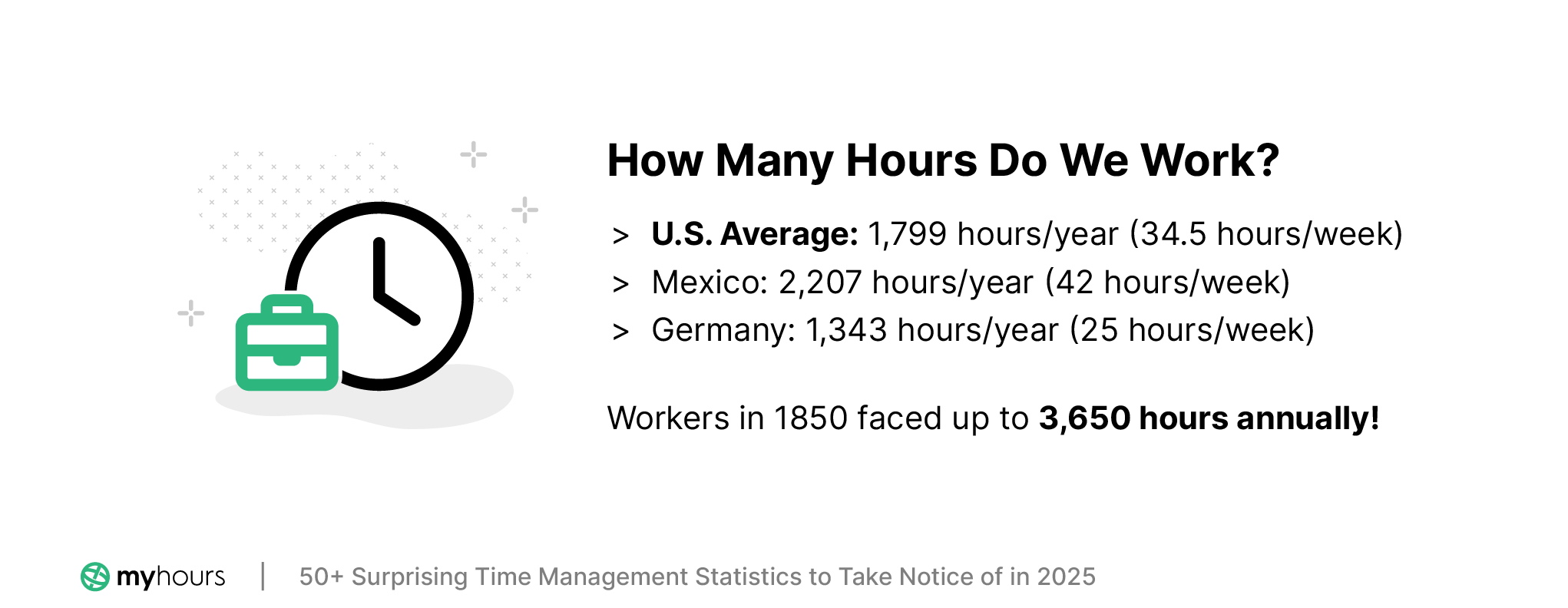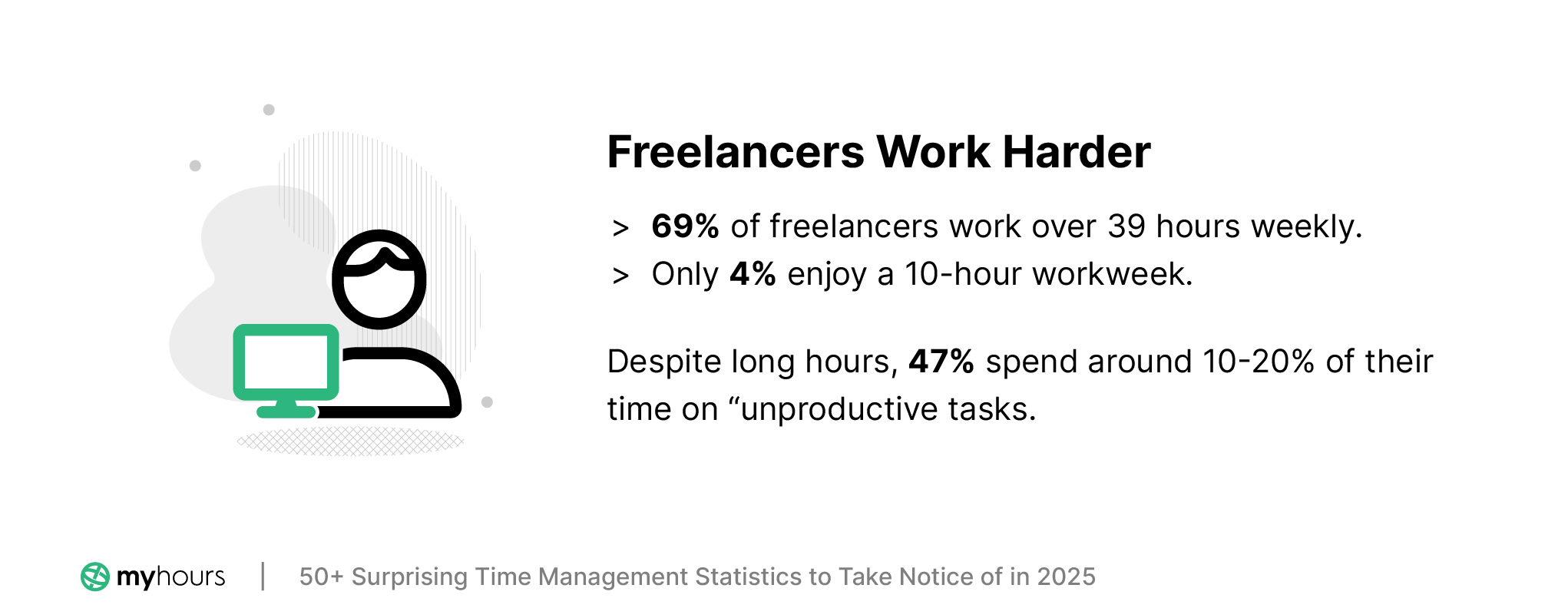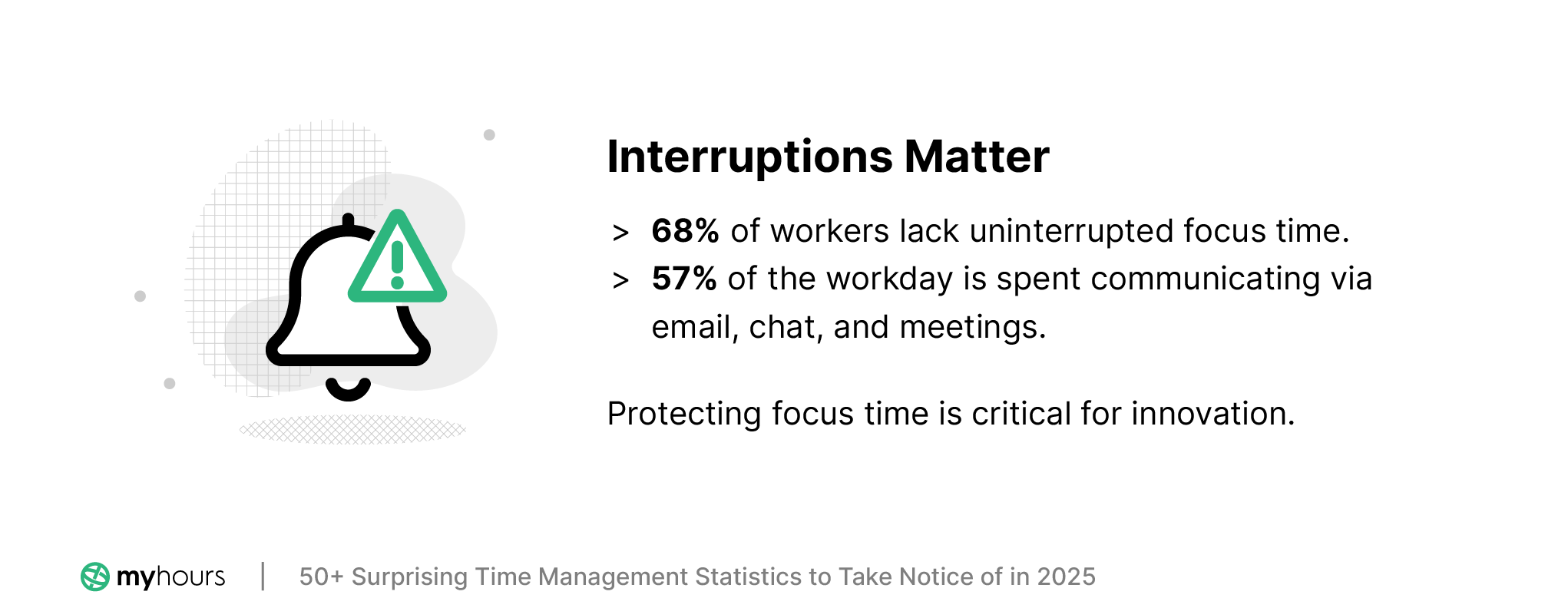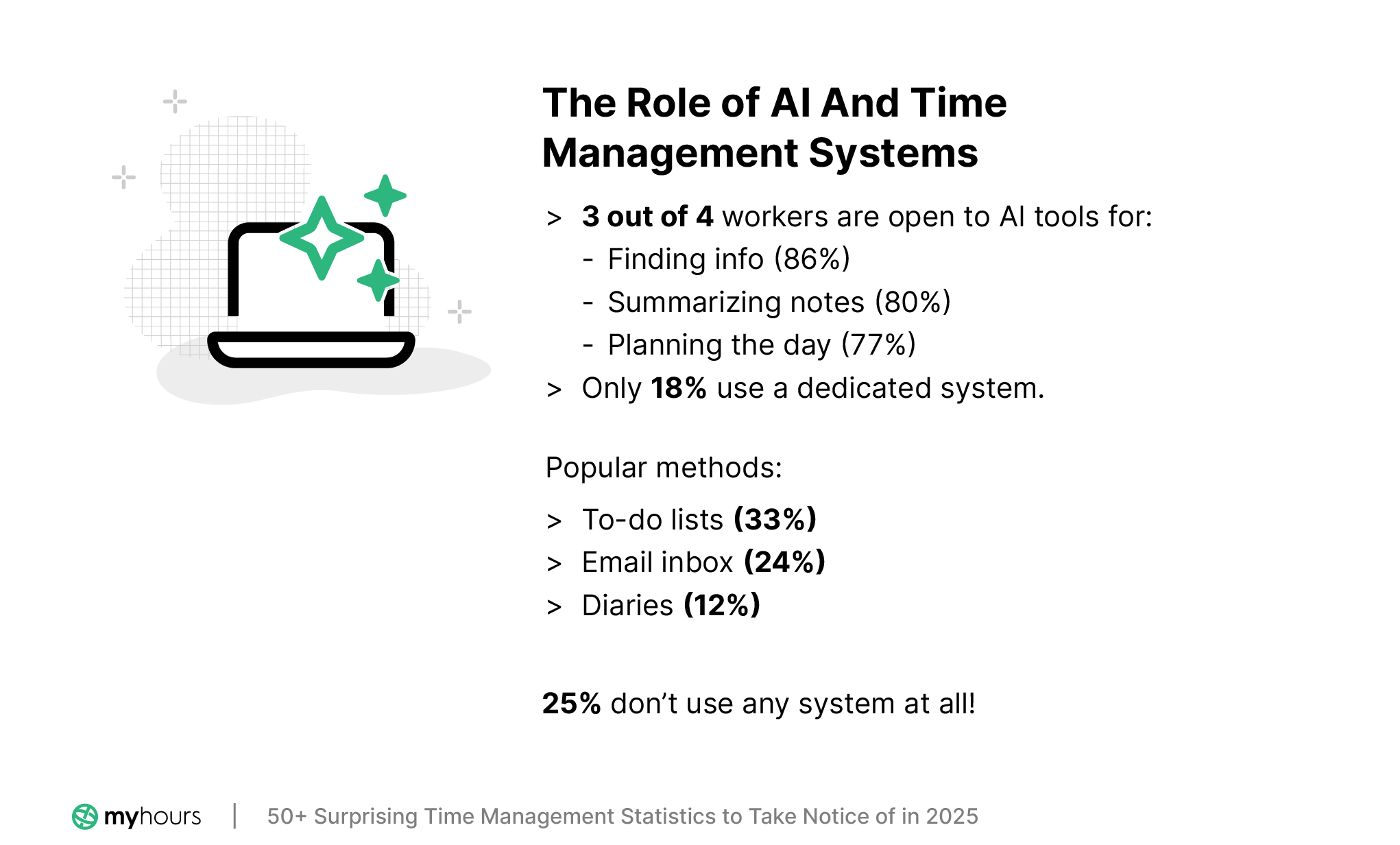Key Findings
- Up to 60% of working hours are spent on less meaningful work
- 68% of people say they don’t have enough uninterrupted focus time
- Only 18% of people have a dedicated time management system in place
- 50% of people using the Eisenhower Matrix say their workload is under control
- On average, we spend up to eight hours online daily
- Tasks take up to 15% longer when trying to multitask
- Good time management is linked to strong performance reviews
Key Time Management Statistics for 2025

The average US citizen works 1,799 hours per year. (Our World in Data)
That’s equivalent to 34.5 hours per week, which isn’t bad. But how does it compare to elsewhere in the world?
- Mexico works 2,207 hours per year (42 per week)
- Canada is 1,865 (35 weekly)
- The UK is 1,524 (29 weekly)
- Germany is 1,343 (25 weekly)
While the US still has a way to go before it enjoys the same working hours as Europe, it’s still a massive improvement from those who had to suffer 3,150 – 3,650 working hours per year in 1850!
How are workers spending their work weeks, exactly?

Freelancers spend more time working than the average office worker, with 69% clocking up more than 39 hours a week. (Freelancermap)
Almost 3,500 freelancers were surveyed across 84 countries, and it was found that:
- The majority of freelancers (31%) work 39-40 hours per week, and 29% work up to 50 hours per week.
- 9% are really putting in the hours and working more than 50 hours weekly.
- Only 4% of freelancers get to enjoy a ten-hour work week or less.
This is an improvement from previous years. Overall, the average number of weekly hours worked in 2023 was 40, compared with:
- 45 in 2022 and 2021
- 44 in 2020
- 43 in 2019
Despite the long working hours, not all of it is productive. The same study found that:
47% of freelancers spend around 10-20% of their time on “unproductive tasks.”
That’s about six hours weekly on tasks like client acquisition, accounting, and customer care.
- 37% devoted less than 10% of their time to unproductive work
- 47% spent between 10 - 20% of their time on these tasks
- 16% clocked up around 20% of their time doing these things
Despite this, 58% of all surveyed said that time management was the main benefit of switching to freelancing.

A 2019 study concluded that more hours – about 60% – are spent on less meaningful work. (Asana 1)
Asana surveyed the behaviors and attitudes of 10,223 knowledge workers across several countries. A knowledge worker was defined as someone who spent 50% or more of their time using a device to complete tasks.
The “less meaningful” work refers to “work about work.” Activities such as communicating, looking for documents, managing priorities, checking emails, etc.
As such:
- Workers found they only had 27% of their time left for skilled tasks
- The remaining 13% was spent on strategizing and planning
Out of the time spent on less meaningful work, 10% was wasted on duplication. That’s over four hours per week on unnecessary repetition.
The reasons for all of these issues were found to be due to a lack of communication – such as working in silos – and inefficient processes.
This correlates with a recent 2024 study that found:
42% of workers say that too much time is spent on "busy work.” (Mercer)
These are the things that don't add value and don’t contribute to productivity.
Other top productivity killers, according to the report, include:
- Too many interruptions and not enough “thinking” time (38%)
- Ineffective organizational structure (35%)
- Too-high workloads (32%)
- Stress (29%)
- Difficulty finding the right information (26%)
Speaking of interruptions…

68% of people said they don’t have enough uninterrupted focus time during the workday. (Microsoft)
In 2023, Microsoft surveyed over 31,000 of its users. According to the time spent in Microsoft 365:
- 23% was spent in Teams meetings
- 19% was spent in Teams Chat
- 15% was spent using email
In total, the average employee spent 57% of their time communicating (in meetings, email, and chat) and only 43% creating or being productive.
That’s over half of the workday spent talking or communicating with other people!
This data is based on a survey that examined how AI can free up time and energy and protect focus time for the creative work that leads to innovation.
And, the tide is turning toward AI. According to the same survey:
3 out of 4 people said they would be comfortable using AI to save time.

Here are the key ways that workers will use AI to do this:
- Finding information (86%)
- Summarizing meetings and notes (80%)
- Analytical purposes (79%)
- Planning the day (77%).
- Administrative tasks (76%)
- Creative work (73%)
This leads back to the previous statistic on how inefficient processes waste time and increase duplication.
Now, there are so many digital apps out there that can streamline processes and help you manage your time, from automated time tracking to payroll software, communication, and everything in between.
Since there’s no need to rely on manual processes, technology should be helping us, right?
Not necessarily.
Only 18% of people have a dedicated time management system in place. (Acuity Training)
That means a whopping 82% of people lack a proper time management system.
Instead, the 2024 study found that this is what people rely on:
- A to-do list (33%)
- Email inbox (24%)
- Scheduling tasks in a diary (12%)
Incredibly, 25% of people don’t have any kind of system at all and say they just deal with the most important thing at that moment in time.
This leads to “firefighting,” where you are reacting to situations as and when they arise. Along the way, important (but less urgent tasks) get swept aside or forgotten.
The result? You feel you are not in control of your workload.
According to the same survey:
50% of people who use the Eisenhower Matrix feel their work is under control daily.
The remaining 50% say the Eisenhower matrix allows them to be in control at least 4 days a week.
The Pomodoro Technique is also very popular, with 60% of people feeling work is under control either 4-5 days per week.
Although time management techniques help, the best method is to use a dedicated time-tracking app to record how the day is spent.
Speaking of apps…
23% of workers using 16 or more apps said their focus was reduced because of app-switching. (Asana 2)
The more apps people use, the more likely they are to say they are less efficient and the more time they waste.
Additionally, 25% of the people using 16 or more apps said they missed messages and actions.
The fewer apps you use, the better things get:
- 15% of people miss messages and actions when using 6-15 apps.
- Only 8% of people experience missed messages and actions when using 1-5 apps
There’s more!
Company leaders using 10 apps daily on average say they could save nearly six hours a week if processes were improved.
Workers using the highest number of apps could save 9.6 hours a week.
It’s no secret that mobile phones are one of the biggest time sinks out there. Whether it’s social media pings or email notifications, it all distracts the same way.
To minimize this problem:
- Delete or disable the most distracting apps
- Mute essential apps and only look at them at certain intervals
- Place the phone out of sight. If you can’t see it, it won’t distract you

On average, people spend eight hours engaging in online activities daily. (Deloitte)
That’s more than half of our waking hours spent online!
Gen Z and Millenials spend even more time online – about nine hours per day. And, the time spent online goes down as we move through the generations:
- Gen X: About seven hours
- Boomers: About six hours
- Pre-Boomers: Four hours or less
The average American will check their smartphone around 144 times a day.

For the average worker in 2019, 51% of the day was spent on time-wasting tasks. (Inc)
- 13% of the day was spent on commuting, with a one-way journey taking 27 minutes on average. No wonder people were so keen to work from home.
- Unnecessary meetings also wasted time – as much as 16%.
But, the biggest time sink was the number of hours we spent with our heads buried in our inboxes.
23% of the day disappeared when dealing with pointless emails. That’s over 2.5 hours a day reading and responding to messages.
Over a 45-year career, that’s ten whole years!
So, how do we curb this obsession?
- During peak working hours, switch off email notifications.
- Assign a limited time to deal with emails and stick to it.
- Stop trying to empty your inbox. Like the laundry basket, it just fills up again.
- Implement policies to limit CC, BCC, and Reply All emails.
Post-COVID-19, it doesn’t look like the meeting situation has improved much.
78% of workers say they’re expected to attend so many meetings that they can’t manage their workloads. (Atlassian)
Meeting overload is responsible for workers having to work overtime, with 51% clocking up extra hours several times a week.
59% of US workers struggle to maintain a positive work/life balance. (Adobe)
The same percentage also finds it hard to keep on top of a growing workload.
One of the main contributors to this problem is those in supervisory roles:
- 70% of workers feel managers have a lack of consideration for their team’s general well-being
- 69% feel that workloads are not distributed appropriately across teams
- 63% are concerned there is not enough clarity regarding goals and responsibilities
Unbalanced workloads have a huge impact on time management and a lack of clarity around responsibility feeds into that. If you don’t know what you’re supposed to be doing, then you don’t know what your workload should be.
Effective leadership is key. And, organizations should implement management training so supervisors understand how to optimize their team’s time.
Across the pond, our Britsh counterparts are also experiencing workload issues.
1 in 2 UK workers feel that work is getting more intense and demanding. (TUC)
“Gruelling” work intensity is a big problem. Employees say they are working harder and longer and must fit more work into working hours.
The result is that work often spills over into private lives.
Overall:
- 55% of workers feel that work is getting more intense and demanding
- 61% say they feel exhausted at the day’s end
- 36% spend more time outside of contracted hours dealing with emails
- 32% spend more time out of hours performing core work
Perhaps most shockingly, 40% of workers have reported that they are required to do more work in the same amount of time.
This means that…
The average UK employee works an additional three extra weeks annually – uncompensated. (Michael Page)
According to the poll conducted by Michael Page:
- Four in ten employees are taking on significant extra responsibilities
- This amounts to five additional tasks in addition to regular duties
Unsurprisingly, overwork leads to burnout which has a big detrimental effect on productivity.
These problems are not just limited to the UK.
In 2024, 31% of US workers said they were required to add more to their plates without decreasing their existing workload. (Yoh)
An additional 34% said they have to push aside activities like exercise, hobbies, and even taking care of their home for the sake of their work.
Disappointingly, 27% say they can’t take time off from work despite wanting to.
Interestingly, it’s those who are mid-way through their careers that are being overburdened:
- 37% of 35–44-year-olds are being given more work without reducing existing workloads, compared with just
- 27% of 55–64 years olds
58% of workers prefer choosing their own hours. (mmhmm)
Flexibility around time management is highly desirable, with 70% of workers saying that asynchronous work is important to job satisfaction.
In contrast, only 32% said they prefer working the same hours as their colleagues.
Working on multiple tasks simultaneously takes 15% more time compared to working sequentially. (ERSJ)
A study exploring the effects of multitasking on individual performance determined that multitasking not only takes more time but also stifles creativity and worsens performance.
Multitasking under pressure presented even more problems and reduced accuracy and decision-making consistency.
Good time management leads to better performance reviews. (PubMed)
A study performed in 2019 conducted a meta-analysis across 158 existing studies on the subject of time management.
Its job was to find out how time management influences job performance and personal well-being. It was found that since the early 1990s, good time management has been increasingly linked to better performance reviews.
However, personality and demographics play a smaller role in time management than you may think:
- Individuals with high levels of conscientiousness displayed better time management techniques.
- Other personality traits had little to no impact.
- There are minimal differences between women and men. Women have very slightly better time management skills than men, but the difference is negligible.
The biggest win around time management is life satisfaction.
The analysis revealed that having good skills in this area significantly boosts life satisfaction – far more than it boosts performance, challenging the common belief that its primary benefit is improved work output.
One could argue, though, that the happier a person is in life, the more likely they are to be productive and engaged at work.
Final Thoughts
Effective time management is challenging without a structure or support in place.
Time management methods help but without a clear picture of where you are spending time, it’s hard to know how to optimize.
Using time-tracking software will build that picture for you. By accounting for every second spent, you can see where it is being wasted. Eliminate your time sinks, and you will suddenly find you have a lot more to spare.
Sources
- Our World in Data: Working hours
- Freelancermap: www.freelancermap.com/blog/freelancer-hours-survey
- Asana 1: Anatomy of Work Index: How people spend time at work
- Mercer: 2024 Global Talent Trends Report
- Acuity Training: Time Management Study 2022
- Asana 2: The Anatomy of Work Global Index 2023
- Deloitte: 2024 Connected Consumer Survey
- Microsoft: 2023 Work Trend Index: Annual Report
- Inc: Average Worker, Expert Opinion
- Atlassian: Meet the #1 barrier to productivity
- Adobe: State of Work Report 2023
- TUC: “Gruelling” work intensity a growing problem
- Michael Page: The impact of overworked employees
- Yoh: Do You Have Job Burnout and Not Even Know It?
- Mmhmm: Truth and Trust at Work
- ERSJ: Multitasking Effects on Individual Performance
- PubMed: Does Time Management Work?

